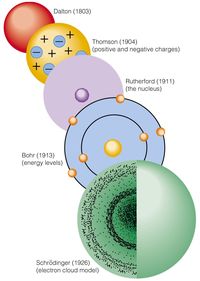
Atomic Models
Quiz
•
Science
•
8th Grade
•
Practice Problem
•
Hard
Standards-aligned

Lisa Thompson
FREE Resource
Enhance your content
15 questions
Show all answers
1.
MULTIPLE CHOICE QUESTION
1 min • 1 pt

This is the most complete and current model of the atom. It consists of 61 elementary particles. Electrons are located in complex orbitals.
The "Quantum Mechanical Model" of the atom
The "Rutherford Model" of the atom
The "Plum Pudding Model" of the atom
The "Bohr Model" of the atom
Tags
NGSS.HS-PS1-1
NGSS.HS-PS1-2
2.
MULTIPLE CHOICE QUESTION
1 min • 1 pt

This model this model was the first to show a nucleus, consisting of protons and neutron. Electrons surround the nucleus but are not shown in distinct energy levels.
The "Nuclear Model" by Rutherford
The "Plum Pudding Model" of the atom by Thomson
The "Quantum Mechanical Modell" of the atom by Heisenberg
Democritus's model of the atom
Tags
NGSS.HS-PS1-8
3.
MULTIPLE CHOICE QUESTION
1 min • 1 pt

This model added on to previous models by showing electrons existed at certain "energy levels". It is often called the Planetary Model.
The "Bohr Model" of the atom
The "Rutherford Model" of the atom
The "Plumb Pudding Model" of the atom
The "Quantum Mechanical Model" of the atom
Tags
NGSS.HS-PS1-1
4.
MULTIPLE CHOICE QUESTION
1 min • 1 pt

This model was developed after J.J. Thompson discovered electrons, a particle smaller than an atom. Is shows electrons floating freely in a positive space.
The "Plum Pudding Model" of the atom
The "Rutherford Model" of the atom
Democritus's model of the atom
The "Quantum Mechanical Model" of the atom
5.
MULTIPLE CHOICE QUESTION
1 min • 1 pt
What can you conclude from the fact that scientists continue to update the atomic model?
New information about atoms continues to be discovered
Old information about atoms is completely useless
Scientists did not have any information about atoms until a few years ago
Scientists still have no idea what atoms look like
6.
MULTIPLE CHOICE QUESTION
1 min • 1 pt

Ernest Rutherford discovered that atoms were mostly _________________.
negatively charged
positively charged
electrons
empty space.
7.
MULTIPLE CHOICE QUESTION
1 min • 1 pt
Idea was of an indivisible particle of matter he called "atomos"
John Dalton
Aristotle
Democritus
Plato
Create a free account and access millions of resources
Create resources
Host any resource
Get auto-graded reports

Continue with Google

Continue with Email

Continue with Classlink

Continue with Clever
or continue with

Microsoft
%20(1).png)
Apple
Others
By signing up, you agree to our Terms of Service & Privacy Policy
Already have an account?
Similar Resources on Wayground

12 questions
Forces
Quiz
•
6th - 8th Grade

17 questions
(2.4) Isotopes and Its Uses
Quiz
•
10th Grade

10 questions
Energy and Environment
Quiz
•
University

12 questions
Topic 11 and 12
Quiz
•
12th Grade

10 questions
AGR232: Chapter 9 Cocoa
Quiz
•
University

15 questions
Synthetic fibers and plastics
Quiz
•
8th Grade

10 questions
Garden plants
Quiz
•
5th - 8th Grade

20 questions
Lesson 04- Procedures
Quiz
•
University
Popular Resources on Wayground

20 questions
Brand Labels
Quiz
•
5th - 12th Grade

11 questions
NEASC Extended Advisory
Lesson
•
9th - 12th Grade

10 questions
Ice Breaker Trivia: Food from Around the World
Quiz
•
3rd - 12th Grade

10 questions
Boomer ⚡ Zoomer - Holiday Movies
Quiz
•
KG - University

25 questions
Multiplication Facts
Quiz
•
5th Grade

22 questions
Adding Integers
Quiz
•
6th Grade

10 questions
Multiplication and Division Unknowns
Quiz
•
3rd Grade

20 questions
Multiplying and Dividing Integers
Quiz
•
7th Grade
Discover more resources for Science

20 questions
Physical and Chemical Changes
Quiz
•
8th Grade

22 questions
Newton's Laws of Motion
Lesson
•
8th Grade

12 questions
Phases of Matter
Quiz
•
8th Grade

20 questions
Distance Time Graphs
Quiz
•
6th - 8th Grade

21 questions
Balanced and Unbalanced Forces
Quiz
•
8th Grade

10 questions
Exploring Newton's Laws of Motion
Interactive video
•
6th - 10th Grade

12 questions
Speed, Velocity, and Acceleration
Lesson
•
6th - 8th Grade

19 questions
Forces and Motion
Lesson
•
6th - 8th Grade
